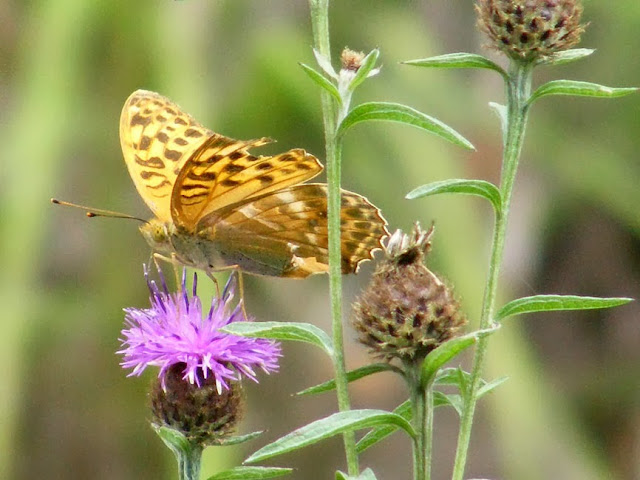Scientific Name: Argynnis paphia ( Nymphalidae Heliconniinae). The specific name is one of Aphrodite's many names, a reference to how beautiful the butterfly is.
English Name: Silver-washed Fritillary (Brush-footed butterfly family, spotted fritillaries sub-family).
French Name: Le Tabac d'Espagne (='the Spanish Tobacco').
5 Key Characters:
- a large butterfly (55 - 75 mm from wing tip to wing tip).
- upper side bright tawny orange with lots of black markings.
- males have wide androconial stripes on the fore wing for dispersing pheromones.
- hind underwing greenish with silvery bands running across.
- often seen nectaring on brambles and thistles.
Lookalikes: Dark Green Fritillary A. aglaja and High Brown Fritillary A. adippe, both of which are smaller, have large white spots on the underside of the hind wing and are much less common.
Habitat: Flower rich woodland edges, rides and clearings, bocage grasslands.
Flight Period: June-July-August-September.
Caterpillar: A spiky looking multi-coloured creature that can be encountered hidden under dead leaves near violet plants. It comes out at night to munch on the violet leaves (Early Dog Violet Viola reichenbachiana, Common Dog Violet V. riviniana, Sweet Violet V. odorata, Parma Violet V. alba.)
Status: Very common, quite widespread and abundant.
Photographed by Loire Valley Nature:
 |
| An extremely tattered male nectaring on CommonTeasel Dipsacus fullonum. |
 |
| An extremely tattered male nectaring on CommonTeasel Dipsacus fullonum. |
 |
| A male nectaring on knapweed Centaurea sp. |
 |
| A female nectaring on knapweed Centaurea sp |
 |
| A male nectaring on knapweed Centaurea sp. |
 |
| Female. |
 |
| Female. |
 |
| A female nectaring on Verbena sp. |
 |
| A female nectaring on Verbena sp. |
 |
| A female nectaring on Verbena sp. |
 |
| Female. |
 |
| Female. |
 |
| Female. |
 |
| A female nectaring on Verbena sp. |
 |
| A female nectaring on Verbena sp. |
 |
| A female nectaring on Verbena sp. |
 |
| A female nectaring on Verbena sp. |
 |
| Male (note the 'sex marks' on the fore wing -- the heavy lengthwise black stripes, which the female does not have). |
 |
| Male. |
 |
| Male. |
 |
| Male. |
 |
| Male. |
 |
| Note the white stripes on a greenish hind wing underside. |
 |
| Note that like all Nymphalidae butterflies, only 2 of the creature's 3 pairs of legs are immediately visible. The third pair is tucked up under the butterfly's 'chin'. |












No comments:
Post a Comment